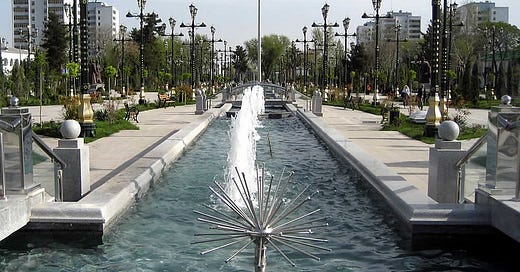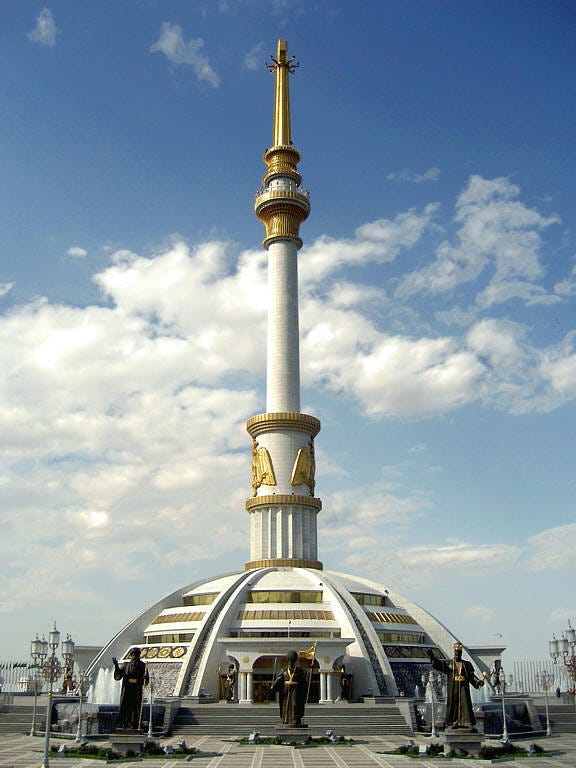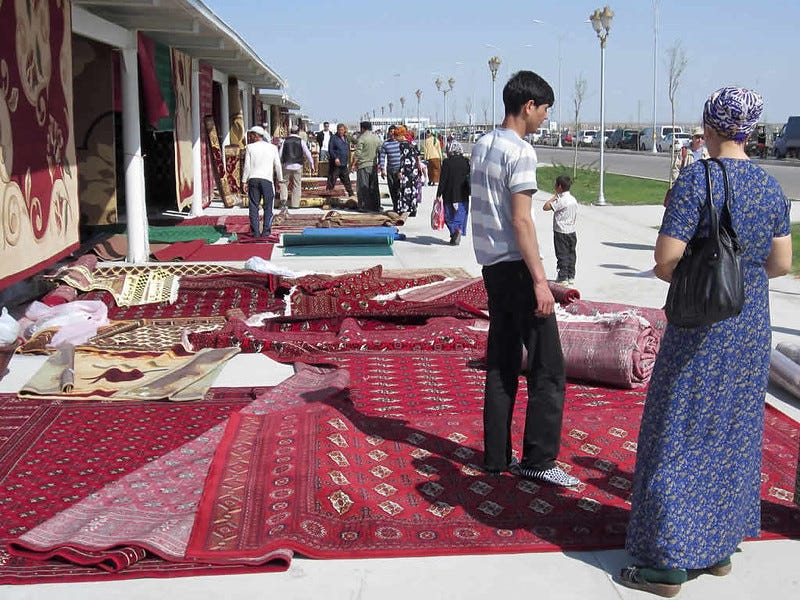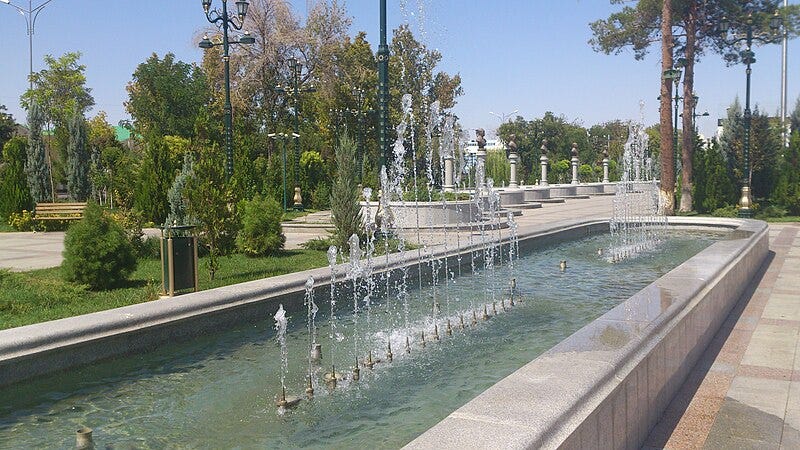One of the persisting questions since the emergence of new states in Central Asia concerns Turkmenistan’s relation to the region as a whole. This began when President Saparmurat Niyazov in 1995 appealed to the United Nations to affirm the country’s non-aligned status, a unique arrangement that the General Assembly passed unanimously. It continued when Turkmen officials remained aloof from early discussions among Central Asian officials about the region’s future.
Early Independence and Isolation
Ashgabat stood alone among Central Asian states when it successfully challenged the crippling low price Russia’s Prime Minister Viktor Chernomyrdin offered for Turkmen gas. In the dark days of 1997 Russia’s state energy monopoly, Gazprom, closed the pipeline to force Turkmenistan to yield. With people starving and the national budget in free fall, Turkmenistan’s president, Saparmurat Niyazov, cut back on just about everything, including education, health, and welfare payments. In the end Turkmenistan prevailed, but it did so as a soloist, not as a member of a regional team. Ashgabat again acted alone when it proposed to China ‘s premier Hu Jintau to deliver Turkmen gas to the China via a pipeline to Khorgos, where it would connect to lines to Shanghai to form the world’s longest gas delivery system. Again it succeeded, but Ashgabat continued to stand aside as Turkmenistan’s Central Asian neighbors mounted several joint initiatives.
In defending this self-preoccupation and their country’s resulting isolation within the region, Turkmen officials argued convincingly that their country inherited from the Soviet Union fewer human resources and essential infrastructures than any of its regional neighbors, and at a time when it faced existential threats from the likes of Chernomyrdin. Turkmen scholars also noted that the Turkmen tribes had endured four centuries of conflict with the Uzbek Khanates and had very few links across the Caspian with Azerbaijan. Thanks to these realities, in the early years after 1991 Turkmenistan found it more useful to develop links with Turkey than with its neighbors in Central Asia.
Diplomats and foreign affairs experts argue over whether and how much this situation has changed today. On one side skeptics point out that when the five regional presidents met in 2022 at the Kyrgyz resort of Cholpan Ata and agreed on two dozen areas for cooperation and coordination, the newly installed Turkmen president, Sardor Berdymukhamedov, held back from signing the document. Rapidly multiplying intra-regional contacts within Central Asia barely extended to Turkmenistan and for all the talk of exporting Kazakh, Uzbek and Turkmen gas to Europe, there is as yet no pipeline across the Caspian.
Signs of Regional Integration
Against all this is the steadily mounting evidence of Turkmenistan’s increased intra-regional engagement. This was initiated immediately after the fall of the USSR, when Ashgabat played a significant role in the decade-long effort involving all five countries that resulted in the United Nations’ declaration of the entire region of Central Asia as a nuclear free zone. Further evidence appeared during planning for the gas pipeline to China. Because it had to cross the territories of two of Turkmenistan’s Central Asian neighbors, the project brought all three governments into regular and positive contact. Further evidence of Turkmenistan’s readiness to be a regional player is nowadays to be found in the growing number of regional contacts involving President Sardar Berdymukhamedov and his chief ministers and their increased travels within Central Asia. It helped that the UN’s General Assembly voted for the first time to acknowledge Central Asia as a world region and included Turkmenistan as an essential part of that region. It also helped that in 2018 the United Nations established in Turkmenistan its Regional Anti-Terrorism Center and that this new body regularly convenes regional conclaves on diverse subjects. But the real action is at more modest levels, in the burgeoning number of emails and phone calls within the Central Asian region and the growth of region-based business travel involving Ashgabat. Studying links between countries in the North Atlantic region back in the 1950s, the American political scientist Karl Deutsch argued convincingly that such interactions eventually create and define contact at the higher level. The same can be said today of Turkmenistan and its Central Asian neighbors.
Key Factors Driving Regional Engagement
At least three developments at the national level have shaped Turkmenistan’s heightened engagement at the regional level. First, as was noted above, in order to advance their gas pipeline to China, the Turkmen had somehow to lay aside four centuries of enmity with Uzbekistan, an enmity reflected on the Uzbek side by the fact that for centuries the only way Turkmen could export their famed carpets was through markets in Uzbek-ruled Bukhara, causing them to be known as “Bukhara” rather than “Turkmen” carpets. This détente was accomplished with astonishing speed by the two presidents, Niyazov and Islam Karimov.
Second, both of Turkmenistan’s gas-producing neighbors, Kazakhstan and Uzbekistan, had long searched for ways to export their gas to international markets without relying on Russia. Both realized that they could accomplish this by sending their gas across Turkmenistan to Iran and beyond and, they hoped, through the eventual development of a trans-Caspian pipeline to Azerbaijan and thence to Turkey and Europe. While this has yet to be achieved, negotiations with both neighbors have proven successful, and Ashgabat has helped turn what might have endured as a competitive relationships into “win-win” ties for all three parties.
Third, one of Turkmenistan’s top priorities has long been to export its gas across Afghanistan to Pakistan and on to India. This ambitious TAPI project (named for Turkmenistan, Afghanistan, Pakistan and India) began decades ago but soon faltered. However, it had not died, and in fact made modest gains under Afghan presidents Hamid Karzai and Ashraf Ghani. It again appeared to have died following the abrupt American departure from Afghanistan. Today, however, Turkmen officials see the possibility of re-launching TAPI by establishing commercial relations with the new Taliban government in Kabul and attracting funding from the Gulf states and elsewhere. Significantly, and for their own economic reasons, all the other states of Central Asia are also seeking to improve their commercial relations with Kabul. While strongly opposing the Taliban’s treatment of women, as well as other Taliban policies, they have all regularized their contacts with Afghanistan and seek to cap them with new rail lines that would open a route from Central Asia to Pakistan and India and thereby overcome their land-locked status and centuries of geopolitical isolation.
Cultural and Historical Debates
In spite of these and other positive developments, both within the region and abroad there remains a certain skepticism over Turkmenistan’s commitment to becoming a full and active partner in the Greater Central Asian project. Most of the arguments advanced in defense of Turkmenistan’s growing regional engagement are rooted in practical issues of the present day, as are many of the criticisms. However, lurking behind both sides of the argument are questions of a deeper cultural nature.
Skeptics, including many within the region, point out that for many centuries the nomadic Turkmen tribes were spoilers, the avowed enemies of the reigning emirates not only in Bukhara but also in Khiva and Kokand. For their part, however, Turkmen see the actions of their tribal predecessors as defensive, a means of survival in the face of what were in facts wars of extermination directed against them. Now, however, this old and mutual enmity is finally fading.
But the question remains: is today’s Turkmenistan truly a part of the world that once produced the great flowering of Central Asian civilization and some of world’s greatest scientists, poets, mathematicians, and theologians? This question could be the subject of learned monographs and scholarly conferences. But there is a much simpler answer, namely, that the Government of Turkmenistan believes deeply that this is indeed the case, and has taken at least one highly visible measure to demonstrate that conviction in a decisively public and permanent manner.
A Symbolic Statement: The Aspiration Park
Anyone can affirm this by taking a walk through the center of Turkmenistan’s capital, Ashgabat. There, extending over three city blocks between two main thoroughfares, Görogly and Magtymguly, is a delightful and impressive new park, opened by President Gurbanguly Berdymukhamedov in 2010. Adorned by mature trees and flower beds and featuring an artificial waterfall and two commodious cafes, its name in Turkmen is, “Ylham,” which means “Inspiration.” Flowing through the center of the entire length of the park is a channel of flowing water, with marble walkways on either side.
At the entrance to this avenue stands an outsized statue of one Assuli, a tenth century chess master from what is now Turkmenistan, who beat the Caliph of Baghdad at chess and lived to write the first-ever book on the game. Beginning a few meters beyond Assuli’s statue begins the park’s centerpiece: a long parade of monumental statues of the giants of Central Asia’s golden age, followed by smaller busts of Turkmen writers from more recent centuries. There, standing grandly between the water channel and the street, stands al Khorezmi (780-850), who gave his name to algorithms and wrote a book that gave algebra its name. Close by stands a stolid Ibn Sina (980-1037), known in the west as Avicenna, the founder of modern medicine and a theologian revered by St. Thomas Aquinas. There, too, one encounters a frowning al Biruni (973-1048), mathematicians, polymath, and the greatest astronomer and social scientist between Thucydides and the Renaissance. Nearby looms the figure of Al Farabi, who helped the West understand Aristotle, and beyond him the great mathematician and globally revered poet, Omar Khayyam (1048-1122).
After visiting this impressive park, the author of this essay had occasion to meet President Gurbaguli Berdymukhamedov, its creator. After accepting compliments on his project, the President was asked if he realized that most of the geniuses memorialized in his park were from elsewhere in Central Asia and were not Turkmen. Some were ethnically Turkic but not of Turkmen stock, while many others arose from the region’s Persianate peoples. Why, then, were they being memorialized in this capital of what some dismiss as a marginal member of the Central Asia community?
The president’s emphatic response was that “Of course, we know they were not Turkmen, but they were all Central Asians, and as such they are as much our own forebears and heroes as they are the noble sons of Uzbekistan, Kazakhstan, Kyrgyzstan, or Tajikistan.”
Looking to the Future
Of course, the words and deeds of a national president may not be mirrored in the views of everyone in his government, let alone of society at large. Yet it is no trivial matter that the leader of a country which many abroad had assumed was following its own idiosyncratic course and ignoring its involvement in the immediate region of which it is a part, had made this emphatic statement of regional identity and solidarity, and that the monuments through which he made this statement have survived to the present.
So long as the Aspiration Park remains, and as long as it is visited and loved by throngs of ordinary Turkmen citizens, we may safely assume that non- aligned Turkmenistan today considers itself to be an integral part of Central Asia as a whole, that it aspires to build on the region’s unique cultural, intellectual, and commercial heritage, and that it can build on this relationship in a manner compatible with its non-aligned status. Whatever pitfalls may exist on Turkmenistan’s path to full participation in this emerging region, the direction of change seems clear.
S. Frederick Starr is Chairman of the Central Asia-Caucasus Institute at American Foreign Policy Council in Washington, DC.








I was in Ashgabat in 2018 and the one thing missing from this park is people. Yes there are a few people in some of these photos, but this part of the city was a large ghost town. Miles of new, white marble-clad high-rise apartment buildings that had almost no people living in them. Wide boulevards with almost no cars. The scale of the place is very large and sterile, in contrast to the older parts of the city with a much smaller, human scale and lots of people all around. Locals call it Ash Vegas.